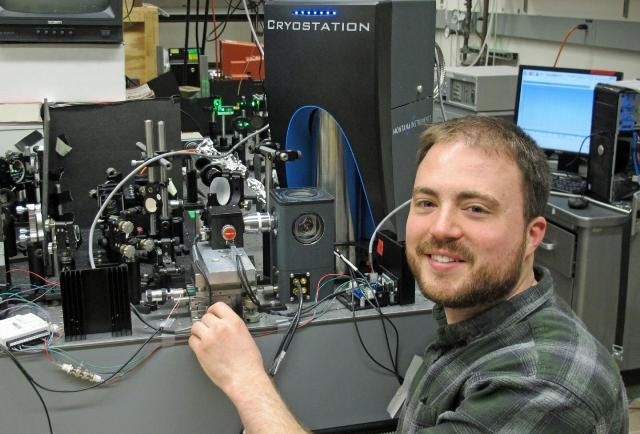Apr 12 2016
Physicists from the University of Oregon have merged sound and light to regulate electron states existing in an atom-like system. This new tool can help move towards quantum-computing systems.
 D. Andrew Golter, a research associate at the University of Oregon, led a project in which sound waves were combined with light waves to control the electronic state, or spin, of qubits in an experimental atom-like system. (Credit: University of Oregon)
D. Andrew Golter, a research associate at the University of Oregon, led a project in which sound waves were combined with light waves to control the electronic state, or spin, of qubits in an experimental atom-like system. (Credit: University of Oregon)
The physicists executed the work on diamond, topped with a zinc oxide layer comprising electrical conductors. The process was carried out at 8oK (-445.27oF, -265.15oC), which is more than absolute zero.
The researchers stated that the transfer of data between quantum bits can be achieved by using surface acoustic waves to cause changes in the electron states. The influence of qubits, evident in binary bits in existing computing, is considered to play a significant role in developing next-generation systems. A detailed report of this research is available in the April 7th issue of the online journal, Physical Review Letters
Computer chips in today's systems are based on electrical circuits. What we have accomplished could lead to a new architecture -- a new way -- to design a computer chip. Instead of using electrical circuits we incorporate sound waves on a chip, with our eyes on acoustic circuits and also on potential applications in tomorrow's quantum computers.
Hailin Wang, Professor, Department of Physics, University of Oregon
The work concentrated on quantum-computing research by leveraging the defects in diamond, referred as nitrogen vacancy centers, where a nitrogen atom is used instead of a carbon atom alongside a missing carbon atom. These defects are artificial atoms capable of being used as qubits.
Scientists are planning to monitor the electron states, or spin, of qubits present in these centers. Wang's lab focuses on incorporating sound waves.
We've brought in sound waves that we can drive into the diamond itself. We can tune the pitch to just the right frequency that lets us control the quantum state.
D. Andrew Golter, Research Associate, University of Oregon
Researchers added sound waves by developing a very small speaker on the diamond’s surface. Sound caused the zinc oxide layer and the diamond to expand back and forth. The sound wave propagates through the diamond surface and then interacts with the NV center. The scientists utilized lasers to track the emitted light, which enabled them to confirm a change in the electron states.
You want qubits to be either on or off We use sound and light to switch them between different states. Light works well for some contexts, but it is sometimes hard to work with. If two qubits are in different locations and we want them to talk to each other, it is difficult to get light to go from one to the other. Light moves fast and can be hard to control. Sound is much slower, and it is easier to make it travel within this material because it automatically travels through solid matter.
D. Andrew Golter, Research Associate, University of Oregon
Wang stated that this newly developed tool based on both sound and light can be used to form logic gates, which are considered to be the building blocks of digital circuitry. These logic gates allow the qubits to communicate with one another.
You can, in principle, use the sound waves to entangle two qubits. For quantum computers you need this.
Hailin Wang, Professor, Department of Physics, University of Oregon
Golter highlighted that for a solid material like a chip, sound could be an appropriate tool to develop a network of interacting atoms, along with sound waves transferring the data from one atom to the next atom.
For basic physics and for potential technological applications, we want to have tools to control single atoms in really tiny systems. Our approach has advantages. Sound is slow compared to light. Sound is confined to the chip. It would be a good way to do operations inside the solid material. We've shown this with a single artificial atom, which now means we should be able to build up to multiple artificial atoms using sound to network them together.
D. Andrew Golter, Research Associate, University of Oregon